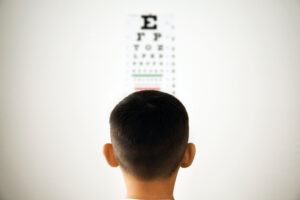sponsored content
December 15, 2023
By Monica Jong, BOptom, PhD, Global Director of Professional Education, Myopia, Johnson & Johnson Vision
Today, we have many treatment options to select from, and having a proactive conversation with the child and their parents will help guide better decision-making for long-term myopia management success.

Photo Credit: GravityImages, Getty Images
Today, myopia may be considered a chronic, progressive disease1 because once a child develops myopia, it tends to progress.2 Every diopter is associated with an increased risk of disease,3 and it is excessive axial elongation that is strongly linked with future disease and vision impairment such as cataracts, glaucoma, retinal detachment, and myopic macular degeneration.4 Therefore, managing myopia is imperative given that the prevalence of myopia is increasing in many parts of the world.5 In the U.S., the prevalence of myopia increased from 25% in the early 1970s to nearly 42% in the early 2000s,6 and myopia is forecast to affect 50% of the world’s population by 2050.5
Recent innovation and advancements in myopia research have led to an explosion of myopia treatments that include specially designed spectacle lenses, soft contact lenses, orthokeratology, and pharmacological† treatments available across various parts of the world.7,8 Today, practitioners have the opportunity to change the lives of pediatric patients with myopia and manage it better than ever. Practitioners have the opportunity to provide personalized care for myopia management by selecting the most appropriate treatment for patients based on their clinical profiles, preferences, and lifestyles.9
Vision-related quality of life may not initially come to mind when you have your patient in your chair, but it should be strongly considered. Talking to the child about what they like to do, understanding their hobbies and activities in daily life, their motivations, and having their parent or caregiver alongside leads to better patient outcomes.10
Studies comparing vision-related quality of life in children wearing spectacles versus contact lenses have found that children wearing contact lenses reported better self-perception, confidence, and participation in activities such as sports.11-14 A study in China also reported that children wearing OrthoK spent more time outdoors,15 and more time outdoors can delay myopia and slow axial elongation as well.16 Time outdoors itself has other health and psychological benefits17 and may help to take children away from screen time.
Additionally, the American Academy of Pediatrics has issued screen time guidelines, and this is something we should be weaving into our conversations with patients and encouraging the 20/20/2 rule — every 20 minutes, look into the distance 20 feet, and go outside two hours per day.18
As practitioners, we know firsthand that a child who is happy with their correction is more likely to wear them. Myopia management studies also demonstrate that greater wear time is associated with better treatment efficacy.19,9 Additionally, contact lenses move with the eyes and are not as easily removed compared with spectacles, which may further improve treatment compliance.
Vision-related quality of life should be considered in myopia management. The pediatric patient in your chair can tell you a lot about who they are and what they like to do and help guide us to the most appropriate treatment option. Ask them if they like to play sports and what sport. Do they like to play video games, and when and how often are they wearing their correction? Is the need for no daytime correction appealing to the patient and parent? Do parents want to be in control or part of the process? If so, contact lenses or OrthoK may be the most appropriate treatment. Today, we have many treatment options to select from, and having a proactive conversation with the child and their parents will help guide better decision-making for long-term myopia management success.
Key Takeaways:
- Vision-related quality of life matters.
- Consider a more holistic and patient-centered approach when managing myopia that takes into consideration patient clinical factors, lifestyle, and preference.
- Every child matters, and every diopter counts.3
RELATED: Read about the insights Dr. Vishaka Thakrar, OD, FAAO, FSLS, shared on ACUVUE Abiliti at THE Myopia Meeting.
 |
Dr. Monica Jong, PhD, BOptom, is Global Director of Professional Education, Myopia, Johnson and Johnson Vision; Honorary Fellow, School of Optometry and Vision Science, UNSW, Sydney, Australia. As Global Director of Professional Education, Myopia, at Johnson & Johnson Vision, she leads practitioner education initiatives around the world to support evidence-based myopia management. She was the former Executive Director of the International Myopia Institute, an organization she helped found and lead. In this role she led the development of white papers and key initiatives to bring consensus to the field of myopia management by bringing together leading researchers, clinicians, educators, policymakers, and public health experts. Dr. Jong has published numerous peer-reviewed articles, co-created the first global online education program in myopia at the Brien Holden Vision Institute, and co-authored the WHO report on the Impact of Myopia and High Myopia. She was the former secretary of the Refractive Error Work Group of the International Agency for the Prevention of Blindness (IAPB) and contributed to position papers and advocacy initiatives in uncorrected refractive error. She has supervised a number of graduate students and speaks regularly at scientific and practitioner meetings on myopia and refractive error. |
References
† Low-dose atropine may be used off-label by ECPs in countries where regulatory approval does not exist. ECPs may be subject to local regulatory, legal, and professional requirements that the ECP must understand and comply with to cover all aspects of off-label prescribing in their country.
- Bullimore, M. A. & Brennan, N. A. The underestimated role of myopia in uncorrectable visual impairment in the United States. Sci. Rep. 13, 15283 (2023).
- Mutti, D. O. et al. The Limited Value of Prior Change in Predicting Future Progression of Juvenile-onset Myopia. Optom. Vis. Sci. Off. Publ. Am. Acad. Optom. 99, 424–433 (2022).
- Bullimore, M. A. & Brennan, N. A. Myopia Control: Why Each Diopter Matters. Optom. Vis. Sci. Off. Publ. Am. Acad. Optom. 96, 463–465 (2019).
- Tideman, J. W. L. et al. Association of Axial Length With Risk of Uncorrectable Visual Impairment for Europeans With Myopia. JAMA Ophthalmol. 134, 1355–1363 (2016).
- Holden, B. A. et al. Global Prevalence of Myopia and High Myopia and Temporal Trends from 2000 through 2050. Ophthalmology 123, 1036–1042 (2016).
- Vitale, S., Sperduto, R. D. & Ferris, F. L. Increased prevalence of myopia in the United States between 1971-1972 and 1999-2004. Arch. Ophthalmol. Chic. Ill 1960 127, 1632–1639 (2009).
- Wildsoet, C. F. et al. IMI – Interventions Myopia Institute: Interventions for Controlling Myopia Onset and Progression Report. Invest. Ophthalmol. Vis. Sci. 60, M106–M131 (2019).
- Walline, J. J. Myopia Control: A Review. Eye Contact Lens 42, 3–8 (2016).
- Gifford, K. L. et al. IMI – Clinical Management Guidelines Report. Invest. Ophthalmol. Vis. Sci. 60, M184–M203 (2019).
- Boland, L. et al. Barriers and facilitators of pediatric shared decision-making: a systematic review. Implement. Sci. IS 14, 7 (2019).
- Walline, J. J. et al. Randomized trial of the effect of contact lens wear on self-perception in children. Optom. Vis. Sci. Off. Publ. Am. Acad. Optom. 86, 222–232 (2009).
- Walline, J. J. et al. Benefits of contact lens wear for children and teens. Eye Contact Lens 33, 317–321 (2007).
- Santodomingo-Rubido, J., Villa-Collar, C., Gilmartin, B. & Gutiérrez-Ortega, R. Myopia control with orthokeratology contact lenses in Spain: a comparison of vision-related quality-of-life measures between orthokeratology contact lenses and single-vision spectacles. Eye Contact Lens 39, 153–157 (2013).
- Yang, B., Ma, X., Liu, L. & Cho, P. Vision-related quality of life of Chinese children undergoing orthokeratology treatment compared to single vision spectacles. Contact Lens Anterior Eye J. Br. Contact Lens Assoc. 44, 101350 (2021).
- Zhao, F., Zhao, G. & Zhao, Z. Investigation of the Effect of Orthokeratology Lenses on Quality of Life and Behaviors of Children. Eye Contact Lens 44, 335–338 (2018).
- Wu, P.-C. et al. Increased Time Outdoors Is Followed by Reversal of the Long-Term Trend to Reduced Visual Acuity in Taiwan Primary School Students. Ophthalmology 127, 1462–1469 (2020).
- Maller, C., Townsend, M., Pryor, A., Brown, P. & St Leger, L. Healthy nature healthy people: ‘contact with nature’ as an upstream health promotion intervention for populations. Health Promot. Int. 21, 45–54 (2006).
- Klaver, C., Polling, J. R., & Erasmus Myopia Research Group. Myopia management in the Netherlands. Ophthalmic Physiol. Opt. J. Br. Coll. Ophthalmic Opt. Optom. 40, 230–240 (2020).
- Cheng, X., Xu, J. & Brennan, N. A. Randomized trial of soft contact lenses with novel ring focus for controlling myopia progression. Ophthalmol. Sci. doi:10.1016/j.xops.2022.100232.
PP2023OTH6263













